Close-Coupled Pumps
Close-coupled is a term used for a pump that shares a single shaft with its motor. Compared to its traditional counterpart, the long-coupled pump, it is built to save money and time while reducing manufacturing and maintenance complexities since it has no separate coupling and frame mount, which requires calibrations and alignments. Manufacturers, pump builders, and repair companies often spend significant time and effort on these calibrations and alignments.
The trend of simplifying a product in manufacturing and maintenance while reducing its footprint is the main reason for the increasing number of pump manufacturers giving special attention to this design over the traditional. A growing number of end users also lean toward choosing this pump when the opportunity presents itself. Different manufacturers pack their pump offerings with various features and advantages over the others, and it’s worth knowing these features before selecting a suitable pump.
Taco 1900 Series, Close-Coupled In-Line Pumps
“Hydraulic performance and reliability” is the name of the game when it comes to Taco 1900 Series close-coupled in-line pumps. These pumps are available in five basic models ranging in size from 1-1/2" x 1-1/2" to 2" x 2" with a flow range of 10 to 250 GPM and head capabilities to 160 feet.

They are compact, energy-efficient, and can be installed anywhere in the piping layout. They are designed to be self-supported by the system piping in either a horizontal or vertical mounting position. Permanently sealed grease-lubricated ball bearings in the motor make the 1900 Series pump virtually maintenance-free. The mechanical seal is an innovative “unitized” design that combines all the components of the rotating element (spring, retainer, bellows, and carbon) into one assembly, making seal replacement quick and easy, and one size seal fits all models.
Aside from these advantages, Taco 1900 Series Pumps come standard with the following features:
- Rear pullout design – allows for servicing of the pump without disturbing the piping
- NEMA standard 56 frame C face motor
- Standard ceramic seal with the new “unitized” design – meets the demands of a wide range of application requirements and facilitates quick and easy replacement simplifying maintenance
- 1/4" NPT pressure tappings – on both suction and discharge connections
- Replaceable corrosion-resistant shaft sleeve with a “built-in” slinger deflects water from the motor bearing in case of a seal leak
- Includes companion flanges
Taco 1900 Series Capacities & Pump Curves
The chart below provides information on the various models of the 1900 series and their capacities:
|
Model |
Speed |
Flange Size |
HP |
|
1911 |
1760 |
1-1/2" (38) |
1/4* (.19) |
|
1/3 (.25) |
|||
|
1/2 (.37) |
|||
|
1 (.75) |
|||
|
3500 |
1-1/2 (1.1) |
||
|
2 (1.5) |
|||
|
3 (2.25) |
|||
|
5 (3.75) |
|||
|
1915 |
1760 |
1-1/2" (38) |
1/3 (.25) |
|
1/2 (.37) |
|||
|
3/4 (.56) |
|||
|
1 (.75) |
|||
|
1-1/2 (1.1) |
|||
|
3500 |
2 (1.5) |
||
|
3 (2.325) |
|||
|
5 (3.75) |
|||
|
7-1/2 (5.6) |
|||
|
1919 |
1760 |
2" (51) |
3/4 (.56) |
|
1 (.75) |
|||
|
1-1/2 (1.1) |
|||
|
2 (1.5) |
|||
|
1935 |
1760 |
2" (51) |
1/2 (.37) |
|
3/4 (.56) |
|||
|
1 (.75) |
|||
|
1-1/2 (1.1) |
|||
|
3500 |
2 (1.5) |
||
|
3 (2.37) |
|||
|
5 (3.75) |
|||
|
7-1/2 (5.6) |
|||
|
1941 |
1760 |
2" (51) |
1-1/2 (1.1) |
|
2 (1.5) |
|||
|
3 (2.37) |
English dimensions are in inches.
Metric dimensions are in millimeters.
Metric data is presented in ( ).
Do not use for construction purposes unless certified.
*1/4 HP AVAILABLE IN 1 PHASE ONLY.
To see how the various Taco 1900 models perform, see below:

Taco 1900 Series Applications
Taco 1900 Series Pumps are one of the first choices when it comes to fluid circulation, but their main design is for circulation with the following parameters:
- Water
- Glycol/water mixture with no more than 50% glycol
- 175 PSIG with cold water and 125 PSIG at the rated temperature
- 250°F standard (300°F with hi-temp seal)
These design parameters lend 1900 Series pumps to a wide range of industries:
- HVAC – The perfect choice for residential and commercial hot water and chilled water circulation. If it runs to provide comfort to people in the vicinity, it should run quietly! The low noise emission of these pumps is a much-appreciated feature.
- Manufacturing Industries – Fewer components mean fewer maintenance areas and fewer parts to replace. These pumps can be very valuable in a setting where downtime costs good money.
- Agriculture & Livestock – The non-corrosive, Cupro-Nickel shaft sleeve, paired with the cast bronze impeller of this pump, is the perfect water circulator for the agriculture industry. Agriculture applications need a pump that will serve efficiently for a long time, even in the harshest locations.
- Fire Protection – With a small footprint and lightweight, the designers, maintenance, and operators will find this pump valuable for those tight installations and clearances usually found on fire protection systems.
- Some other examples of suitable applications for the pump are the following: LoadMatch™ Systems, Golf Courses, Dry Cleaning Plants, Booster Service, Bottle Washers, Lawn Sprinklers, and Laundry Equipment.
Taco 1900 Series Start-Up, Maintenance & Repair
Start-Up
- Wire the motor according to the nameplate specifications. The warranty is void if the motor is damaged due to improper electrical installation.
- If a magnetic starter is used, see that the heater element is sized for the service factor load of the motor otherwise, nuisance circuit breaker trips may occur.
- Before starting the motor, ensure that the pump is filled with water to lubricate the seal. Do not operate the pump dry; this will result in seal failure.
Maintenance
For maintenance, the Taco 1900 Series uses permanently sealed bearings, eliminating the need for lubrication on the pump end.
Repair
For repairs, Taco has available parts on the following and are replaceable:
Seal
- Disconnect the electrical connections. Relieve the system pressure, reduce the system temperature to ambient and drain the water from the body.
-
Remove the motor and bracket assembly from the pump body (Figure 1).
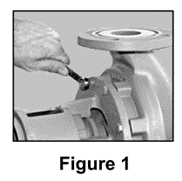
- Place the bracket in a vertical position with the impeller up and loosen the bolt at the center of the impeller, two turns (7/16" Hex Head). This bolt has a REVERSE (left-handed) thread. Tap the impeller at its outside diameter with the hammer’s handle to free the tapered fit between the shaft and the impeller and completely remove the bolt, washer, and impeller (Figure 2).
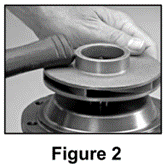
-
Remove the complete rotating element, which includes the spring retainer washer, spring, rotating seal assembly, and rubber bellows. Next, remove the stationary seat from the recessed end of the bracket. It may be necessary to pry it loose (Figure 3). Important Note: The original seat may be difficult to see but must be removed before installing the new seat (Figure 4).
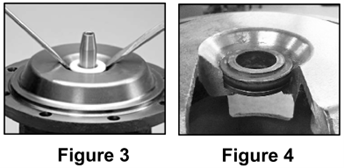

- Thoroughly clean the shaft sleeve and the seat cavity.
- Insert the new seat. For easy assembly, coat the seat rubber with the special grease provided in the small container. Do NOT use any other oil or grease. Push the seat down into the cavity (Figure 5). The seat must not be cocked relative to the shaft. Be sure the face of the seat stays absolutely clean – wipe the surface with a soft, clean cloth if necessary.
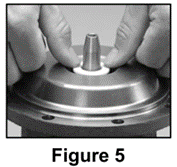
- Install the new rotating seal assembly. Coat the inside of the rubber bellows with the special grease provided. Do NOT use any other oil or grease. Be sure the carbon face remains absolutely clean. Slide the assembly, carbon first, over the shaft until the carbon meets the seat. Install spring and spring retainer washer (Figure 6).
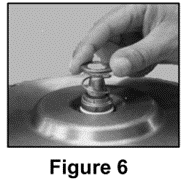
- Ensure the mating surfaces of the shaft sleeve and impeller are clean. Replace the impeller using the new impeller bolt and washer provided—torque to 9 ft-lbs.
- Clean the gasket surfaces of both the casing and the bracket. Reassemble the motor/bracket assembly to the casing using the new gasket.
- Follow the procedure outlined under the Start-Up section.
Impeller
Follow steps 1 → 3 and 8 → 10 outlined in the Seal section.
Motor
- Follow steps 1 → 4 in the Seal section.
- Remove the bracket from the motor.
- Loosen the set screws and remove the shaft adaptor and sleeve, being sure to reclaim the original shaft key from the motor. Note: The key provided with the new motor must be modified to the length of the original before it is installed if the original is not being reused.
- Thoroughly clean the shaft sleeve and reuse it or install a new shaft sleeve (Part #1600-205RP).
- Insert the shaft adaptor onto the motor shaft, and press until it bottoms out against the end of the motor shaft (Part # 1900-008RP).
- Tighten set screws beginning with the two keyway set screws.
- Slide the bracket over the shaft adapter assembly and secure it to the motor.
- Follow steps: 5 → 10 in the Seal section.
Taco 1600 Series vs. 1900 Series Pumps
Taco has a more traditional offering similar to the 1900 Series, which is the Taco 1600 Series. Below are some similarities and differences between the two pump lines:
|
Taco 1600 Series |
Taco 1900 Series |
|
|
Maximum Head |
68 ft |
160 ft |
|
Pressure |
175 psi Maximum Operating Pressure (125 psi Flanges Standard) |
175 psi Maximum Operating Pressure (125 psi Flanges Standard) |
|
Temperature Mechanical Seal |
250°F (300°F Optional) |
250°F (300°F Optional) |
|
Motors |
NEMA Standard, Resilient Mounted |
NEMA Standard 56 Frame C Face |
|
Coupler |
Flexible Type |
N/A (Close-Coupled) |
|
Metering Ports |
Tapped Suction & Discharge Ports Standard |
Tapped Suction & Discharge Ports Standard |
|
Flange Sizes |
1-1/2", 2" |
1-1/2", 2" |
|
Pump Flanges |
Available with the Pump |
Available with the Pump |
|
Pump Bearings |
Ball Bearing Replaceable Cartridge |
N/A (Close-Coupled) |
|
Advantages |
|
|
|
Disadvantages |
|
|
To know more about the Taco 1600 Series In-Line Pumps, click here: Taco 1600 Series In-Line Pumps.
Replace Your 1600 Series With a 1900 Series Pump
Since the Taco 1600 Series only has a maximum head of 68 ft, there will always be a Series 1900 that can replace it. You can replace your 1600 Series with no impact on the system piping.

Dimension “D” on the pump diagram above is also the existing clearance of your piping from using the Taco Series 1600 will be virtually the same when replaced by its Taco Series 1900 counterpart.
Let us know your existing Taco 1600 Series In-Line Pump model, and we can recommend a proper Taco 1900 Series crossover model!
A Smarter Series 1900
For applications that will benefit from using a VFD or ECM motor and all the advantages that come with it, Taco also has you covered with the Taco 1900e Series, Close-Coupled In-Line Pump.
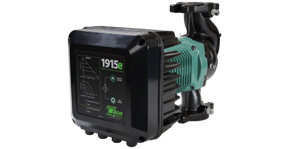
The Taco 1900e Series, close-coupled in-Line pump comes in three operating modes:
- Constant Pressure Mode – Ideal for zoning applications that use two-way zone valves. Regardless of the number of open zones, the amount of head remains the same as the discharge pressure changes.
- Proportional Pressure – Maintains a variable pressure differential in the system as the heating load increases or decreases. Flow changes in relation to the change in pressure differential. It is the best option for zoning by TRV or three-way valve applications.
- Constant Speed Mode – Matches the speed to the design load conditions. This mode is best for zoning by circulators.
It also has a 0-10V mode that enables pump communication with the building automation system, and a two-pump operation feature that allows it to work with a secondary pump.
You can know more about the 1900e series here: Taco 1900 Series Pumps.
Interested in the Taco 1900 Series, Close-Coupled In-Line Pump? Here is the information you need to know:
- Your flow requirement (in Gallons per Minute or Liters per Second)
- Your head requirement (in meters or feet)
- The make and model of your existing circulator pump (if you have any)
- Do you need Building Automation System Capabilities?
You can give us this information, and we can help you get the right Taco 1900 Series close-coupled in-line pump model for you!

